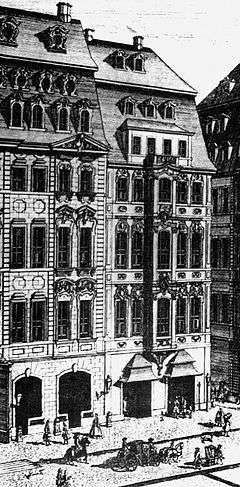''Tönet, ihr Pauken! Erschallet, Trompeten!'' BWV 214
| Tönet, ihr Pauken! Erschallet, Trompeten! BWV 214 | |
|---|---|
| Secular cantata by J.S. Bach | |
 Zimmermannsches Caffeehaus, 1700s | |
| Performed | 8 December 1733: Leipzig |
| Movements | 9 |
| Vocal | SATB choir and soloists |
| Instrumental |
|
Tönet, ihr Pauken! Erschallet, Trompeten! (Resound, ye drums! Ring out, ye trumpets!), BWV 214,[lower-alpha 1] is a cantata by Johann Sebastian Bach, composed in 1733 as a congratulatory cantata for the birthday of Maria Josepha, Queen of Poland and Electress of Saxony. The work in nine movements is scored for four vocal parts and a festive orchestra with trumpets and timpani, flutes, oboes and strings. Bach used movements from the cantata again in his Christmas Oratorio, notably for its first movement.
History and text
Bach composed this cantata in 1733 to honor the 34th birthday of Maria Josepha, Queen of Poland and Electress of Saxony.[1] It is also known as Glückwünschkantate zum Geburtstage der Königin (Congratulation cantata to the Queen's birthday). The librettist of the text is unknown, but may have been Bach himself.[2]
The cantata was first performed at the Zimmermannsches Caffeehaus in Leipzig on 8 December 1733.[3]
Parts of this secular work were reworked for Bach's Christmas Oratorio,[3] including its first movement, in which the voices imitate the sound of timpani and trumpets even with the new text "Jauchzet, frohlocket" (Shout for joy, exult).[1][4]
Scoring and structure
The work features four vocal soloists who represent allegorical figures: Bellona (soprano), Pallas (alto), Irene (tenor), and Fama (bass). It is further scored for a four-part choir, three trumpets, timpani, two flutes, two oboes, oboe d'amore, two violins, viola, cello, violone, and basso continuo.[5]
It has nine movements (mvts.):
- Chorus: Tönet, ihr Pauken! Erschallet, Trompeten! (→

- Recitative (tenor): Heut ist der Tag
- Aria (soprano): Blast die wohlgegriffnen Flöten
- Recitative (soprano): Mein knallendes Metall
- Aria (alto): Fromme Musen! meine Glieder (→

- Recitative (alto): Unsre Königin im Lande
- Aria (bass): Kron und Preis gekrönter Damen (→

- Recitative (bass): So dringe in das weite Erdenrund
- Chorus: Blühet, ihr Linden in Sachsen, wie Zedern (→

Music
The opening chorus is a very long da capo form. Unusually for Bach, it opens with a timpani solo. The vocal lines are mostly homophonic or imitative – it is the instrumental forces that are the focus of the movement. Musicologist Julian Mincham notes that "the sweeping exhilaration of this movement is impossible to describe in words".[6]
The tenor recitative conveys imagery of a thunderstorm and is followed by a soprano aria and recitative representing the "clashing of arms" and the battlefield. The alto aria, the only movement in the minor mode, includes a prominent oboe d'amore, while the following recitative is accompanied by chordal strings.[6]
The bass da capo aria has a majestic obbligato trumpet line that underlines the "triumph, dignity and splendor" of the queen. The text focuses on the dual themes of fame and virtue. The penultimate movement is a bass recitative with a woodwind accompaniment. The piece ends with a dance-like chorus.[6]
Recordings
- Kantorei Barmen-Gemarke, Helmut Kahlhöfer, J.S. Bach: Cantatas BWV 207a & BWV 214, Cantate 1961
- Amsterdam Baroque Orchestra & Choir, Ton Koopman. J.S. Bach: Complete Cantatas Vol. 4. Antoine Marchand, 1996
Notes
- ↑ "BWV" is Bach-Werke-Verzeichnis, a thematic catalogue of Bach's works.
References
- 1 2 Dürr, Alfred; Jones, Richard D. P. (2006). The Cantatas of J. S. Bach: With Their Librettos in German-English Parallel Text. Oxford University Press. pp. 102, 820, 827–830. ISBN 978-0-19-929776-4.
- ↑ "Cantata BWV 214". Bach Cantatas Website. Retrieved 7 June 2013.
- 1 2 "Tönet, ihr Pauken! Erschallet, Trompeten! BWV 214; BC G 19 / Secular cantata (Birthday)". Bach Digital. Retrieved 16 November 2017.
- ↑ "Cantata No. 214". AllMusic. Retrieved 7 June 2013.
- ↑ "BWV 214". University of Alberta. Retrieved 7 June 2013.
- 1 2 3 Mincham, Julian. "Chapter 95 BWV 214". jsbachcantatas. Retrieved 7 June 2013.
External links
- Autograph score in the Berlin State Library (Staatsbibliothek zu Berlin)
- Tönet, ihr Pauken! Erschallet, Trompeten!, BWV 214: Scores at the International Music Score Library Project (IMSLP)
- BWV 214 – "Tönet, ihr Pauken! Erschallet, Trompeten!": English translation, discussion, Emmanuel Music
- BWV 214 Tönet, ihr Pauken! Erschallet, Trompeten!: English translation, University of Vermont